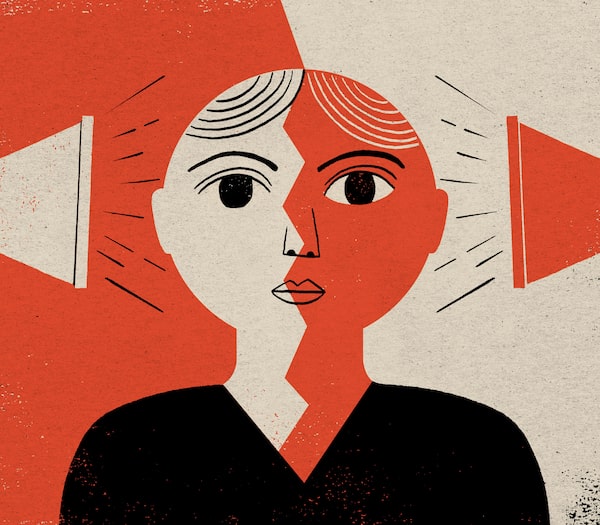
Illustration by Hanna Barczyk
I love amusement-park rides, but not ones that actually threaten my life. Unfortunately, living in Ontario, I feel every day the nauseating and discombobulated sensation of having stepped off a ride being operated by a drunk carney. Except the carney is the provincial government we’ve elected.
It is enraging to live in a province where the public-health policies, and attendant messaging, have been so confused and poorly aimed at communities most affected by the COVID pandemic. Just this week, Premier Doug Ford put the province under a new stay-at-home order while insisting he did not know that things would get this bad – even though his own science advisers had been warning about the firestorm of coronavirus variants for weeks.
Rage isn’t very useful at this point, even if it does feel good to vent. So, instead of complaining about how I don’t know what colour danger zone we’re in (maybe fuchsia?), I thought I’d ask a few communications experts about the consequences of confused public-health messaging, and what could be improved for the next time we face such a crisis.
“We’re now on what I call the Tilt-a-Whirl ride of government communications,’' says Josh Greenberg, director of the journalism school at Carleton University and a scholar of science communication, who shares my love of theme-park metaphors. ’'We’re all experiencing collective whiplash. Unfortunately it’s not thrilling and we’re not getting on this ride by choice.”
The situation is, obviously, complex and fluid. We’re in a catastrophe that hopefully will be a once-in-a lifetime event. Still, lessons from previous public-health crises reveal that the best communications strategies are clear, flexible, honest about the state of science and data, targeted at the most vulnerable communities, tied to good policy, and (crucially) untainted by political concerns. Failure to adhere to those guidelines can lead to a perilous erosion in public confidence. This is the cliff’s edge we’re standing at now.
“In a health crisis, lives are at stake,” says Shana MacDonald, associate professor of communications at the University of Waterloo. “When public trust is eroded, we stop listening and we start to make our own rules. We don’t listen to any well-meaning advice from any institutions. At that point, you don’t have a group of citizens acting together for the common good.”
It wasn’t always this way. At the beginning of the pandemic, people were willing to give provincial and federal governments the benefit of the doubt. Formerly obscure chief medical officers of health were hailed as heroes, and many are still regarded that way. But in certain parts of the country cynicism has crept in as health measures failed to reach the most vulnerable people, and communications strategies appear to have been written in Klingon. Were we in lockdown? Shutdown? Stay at home? People threw up their hands when words ceased to have common meaning.
Even worse, the debate has become politicized, a lethal poisoning for effective messaging. Spats have broken out between provincial governments and Ottawa over the vaccine rollout, with each side accusing the other of “playing politics.” Votes seem more important than lives. “As the pandemic has dragged on, the polarization of our public discourse has become more amplified,” Dr. Greenberg says. “We see this in the dangerous game of one-upmanship between the federal and Ontario governments over the issue of vaccine distribution, and in the all-or-nothing debate over school closures.”
There is still a relatively high level of trust in scientists and medical professionals, which leads to one bright spot in this very bleak landscape. People in health care who might have previously been unwilling to take a public stand, such as doctors and nurses, have become outspoken advocates for transparency and more humane care, even if it means their own jobs are threatened. “We need these voices to be part of the broader public discussion and I’m thankful and grateful that we’re seeing more people from those communities step up,” says Timothy Caulfield, professor of health law and science policy at the University of Alberta. “We have to have their backs. They have to be incentivized to do this, and protected and supported if they choose to do so.”
Dr. Caulfield also points to the increasing polarization of the debate around public-health measures, not just between political parties, but also between neighbours who have taken ideological stands around everything from masks to vaccine passports. “It becomes more about the camp you’re in, and less about the science. And then it becomes very hard to change people’s minds.”
One of the solutions is for public officials to be brutally honest and upfront about the fluid nature of science and data. This is where media outlets have a role to play, letting the public know that, especially in times of fresh crisis, data is not going to be fixed and immutable. It will change. Recommendations around masks that seemed sensible in February, 2020, had morphed by February, 2021, and that is not a sign that expertise is flawed – rather, that it’s working as it should. I once read that “science is an argument that takes place in public.” That understanding has to be better communicated to the public.
After every great health crisis in this country, there have been inquiries and proposals for better messaging, many of which have fallen by the wayside. “Developing better communications, more nimble, more targeted, will certainly be among the recommendations that come out of this,” Dr. Greenberg says. “Whether we learn from those recommendations remains to be seen. And no amount of good communication is going to be effective when you have poor public policy.”
Keep your Opinions sharp and informed. Get the Opinion newsletter. Sign up today.